Llanfyllin is an ancient market town situated in the county of Montgomeryshire, mid-way between Shrewsbury and Bala, which lies in the valley of the River Cain, near the Berwyn Mountains, some 14 miles southwest of Oswestry. The town has two war memorials, with identical names, one in the town square, and one inside St. Myllin’s Church. The memorials commemorate the 34 local men who fell during the Great War, and a further 12 men who fell during World War Two. The memorial in the square was unveiled by Major Lomax in September 1920, and takes the form of a Celtic Cross, while the Church memorial takes the form of a tablet, with an added panel for the WW2 names.
The Great War, 1914-1918
Thomas Ball, Private, 36038, Sherwood Foresters (Notts and Derby Regiment). Thomas was born in Derby in 1892, the son of Edwin and Ellen Ball. On 10 November 1915 he married Elizabeth Evans, the daughter of William Henry Evans and Sarah Elizabeth Evans, of Llanfyllin. Thomas enlisted into the Sherwood Foresters (Notts and Derby Regiment), and after completing his training, was posted to France in the winter of 1916-17, joining the 10th Battalion, Sherwood Foresters. The battalion was attached to 51 Brigade, 17th (Northern) Division. Thomas saw his first major action during the Battle of Arras in the Spring of 1917. The Division then moved north and took part in the First and Second Battles of Passchendaele. In March 1918 the Division was on the Somme, and faced the German Spring Offensive there, suffering heavy casualties as it was forced to withdraw over the coming days. The Division then fought at the Battle of Amiens on 8 August 1918, a day which saw the war swing in the favour of the Allies. The Allies then advanced on the Somme, and the Division fought at the Battle of Albert later that month, then on to the Battle of Bapaume on 31 August, advancing towards the Hindenburg Line, fighting at the Battle of Havrincourt on 12 September and the Battle of Épehy on 18 September. At the beginning of October, the mighty Hindenburg Line was broken, and the 17th Division swept towards Cambrai, fighting at the Battle of Cambrai on 8 October, and then north-east through northern France, towards the old Battlefields of Mons and Le Cateau, during the Pursuit to the Selle and the Battle of the Selle during the middle of October. The final major battle faced by the Division during the Great War was the Battle of the Sambre on 4 November 1918. Thomas survived the war, but his health had been affected, and he died on 4 May 1921, aged 28. He was buried in Duke Street Cemetery, Southport. His widow, Elizabeth, returned to Llanfyllin and married John Ellis there in 1928. Thomas is not commemorated on the Llanfyllin war memorial.
George Bennion, Private, 290839, Royal Welsh Fusiliers. George was the son of George and Mary Bennion, of 3, Coedllan Terrace, Llanfyllin. He worked as a farm servant prior to the war. George enlisted into the 7th Battalion, Royal Welsh Fusiliers at Llanfyllin on 16 November 1914. The battalion was a Territorial unit, which mobilised for war at Newtown in August 1914, as part of North Wales Brigade, Welsh Division and moved to Conway until the end of the month, before moving to Northampton. In December the Division moved to Cambridge and then in May 1915 to Bedford, where the Division was numbered and the formation became 158 Brigade, 53rd (Welsh) Division. On 19 July 1915 the entire Division sailed from Devonport for Imbros and on 9 August 1915 landed at Suvla Bay. The infantry moved off the beaches into the bush, but due to a lack of maps and no knowledge of the terrain, many of the units became disorientated, and the situation became chaotic. The Division was eventually evacuated from Gallipoli in December 1915, moving to Egypt to join the EEF, and helped guard the Suez Canal before taking part in operations to drive the Turks out of the Sinai. The EEF then turned its attention onto driving the Turks out of Palestine, and on 26 March 1917 launched its first offensive against the coastal city of Gaza, which guarded the road to Jerusalem. Initial gains during the day were lost when the assaulting divisions lost touch with each other and communication broke down when a thick fog cloaked the battlefield. George had been killed in action during the fighting that day. The 21-year-old is buried in Gaza War Cemetery.
Oswald Evan Bennion, Private, 21684, The King’s (Liverpool Regiment). Oswald was the son of Charles and Elizabeth Bennion, of Berllan, Llanfyllin. He worked as a joiner at Liverpool prior to the war. Oswald enlisted at Liverpool into the 19th Battalion, King’s (Liverpool Regiment) on 26 September 1914. The battalion was raised in Liverpool by Lord Derby, and on 30 April 1915 moved to Belton Park, Grantham to join 89 Brigade, 30th (West Lancs) Division. On 6 November 1915 Oswald embarked for France with the battalion, and the entire Division moved to Buigny L’Abbe before assembling around Vignacourt by 18 November. The Division initially took over positions near Foncquevillers, but in the middle of January 1916 moved to positions in the Somme valley, taking over front-line trenches near Carnoy, where its infantry battalions began the usual routines of trench rotation, usually four days in the front line, four in support and four in reserve. The only breaks came when the various units were withdrawn from the front to undergo systems of training, in readiness for the forthcoming Somme offensive. At dawn on 1 July 1916 the 30th Division attacked from Maricourt, suffering heavy losses during the day as it captured its objective of Montauban. The Division held the line here over the coming weeks, as fighting raged along the Somme front. At dawn on 30 July 1916 the Division launched an assault from its new positions in Maltzhorn Trench, but suffered terrible losses before being forced to withdraw. Oswald was reported to have been wounded during the attack and was on his way back to the aid station, but was in the act of dragging another wounded comrade into the shelter of a shell-hole, when they got spotted by a party of Germans, who shot Oswald dead. The 19-year-old was originally buried where he fell by men of the 7th King’s (Liverpool Regiment), but his grave was lost during further fighting, so he is today commemorated on the Thiepval Memorial, France. Oswald is not commemorated on the Llanfyllin war memorial, but is commemorated at Llanfechain and Bwlch-y-Cibau.
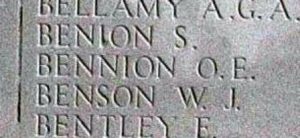
William Edgar Brown, Lance Corporal, 290126, Royal Welsh Fusiliers. William was the son of Sarah Jane Brown, of Pentre, Llanfyllin. He had worked as a farm labourer at Ty Ucha, Bwlch-y-Cibau, and then became a postman prior to the war. William enlisted into the 7th Battalion, Royal Welsh Fusiliers at Llanfyllin on 1 November 1912, and had attended the annual summer TA camps at Rhyl and Aberystwyth prior to the outbreak of war. The battalion was a Territorial unit, which mobilised for war at Newtown in August 1914, as part of North Wales Brigade, Welsh Division and moved to Conway until the end of the month, before moving to Northampton. In December the Division moved to Cambridge and then in May 1915 to Bedford, where the Division was numbered and the formation became 158 Brigade, 53rd (Welsh) Division. On 19 July 1915 the entire Division sailed from Devonport for Imbros and on 9 August 1915 landed at Suvla Bay. The infantry moved off the beaches into the bush, but due to a lack of maps and no knowledge of the terrain, many of the units became disorientated, and the situation became chaotic. The Division was eventually evacuated from Gallipoli in December 1915, moving to Egypt to join the EEF, and helped guard the Suez Canal before taking part in operations to drive the Turks out of the Sinai. The EEF then turned its attention onto driving the Turks out of Palestine, and on 26 March 1917 launched its first offensive against the coastal city of Gaza, which guarded the road to Jerusalem. Initial gains during the day were lost when the assaulting divisions lost touch with each other and communication broke down when a thick fog cloaked the battlefield. William was killed in action during the heavy fighting that day. The 25-year-old is buried in Gaza War Cemetery, Israel.
Stephen Joseph Chase, Private, 306658, Lancashire Fusiliers. Stephen was the son of Joseph and Eliza Chase, of Pendalog Cottage, Llanfyllin. The family moved to 104, Folly Lane, Swinton, Manchester at some time after 1911. Stephen enlisted into the Lancashire Fusiliers at Lower Broughton, Manchester, and after completing his training, was posted to France in the winter of 1916-17, joining the 1/8th Battalion, Lancashire Fusiliers. The battalion had taken part in the Gallipoli campaign, attached to 12 Brigade, 42nd (East Lancs) Division, before being evacuated to Egypt by January 1916. The Division moved to the Western Front in February 1917, landing at Marseilles on 2 March, and entrained for the Somme, moving to positions near Péronne before taking over the front line near Épehy. As well as carrying out the usual routines of trench rotation, four days in the front line, four in support, and four in reserve, the men were also kept busy on repairs to roads and trenches, following the devastation wrought by the Germans as they withdrew towards the Hindenburg Line. On the night of 22-23 May, the 1/8th Lancashire Fusiliers moved back into the front line at Equancourt, to begin a routine tour in the trenches. Apart from an uneventful fighting patrol, the spell in the line was a quiet one, but when the battalion was being relieved on 25 May 1917, the Germans opened up an artillery barrage onto their positions before launching a trench raid onto their lines. Stephen was killed in action during the short engagement. The 22-year-old has no known grave and is commemorated on the Thiepval Memorial, France.
John Coxall, Corporal, 7682, King’s Shropshire Light Infantry. John was the son of Edward and Mary Coxall, of Wistanstow. He married Elizabeth Annie Francis at Clun in 1909, and the couple moved to Winford Cottage, Llanfyllin, where John had found work as a farm labourer. He enlisted at Ludlow into the 1st Battalion, King’s Shropshire Light Infantry soon after the outbreak of war. The battalion had been in Tipperary, attached to 16 Brigade, 6th Division, but the Division was swiftly recalled to England, before embarking for France, and landed at St. Nazaire on 10 September 1914. John embarked with the battalion, so probably had some pre-war service. The Division then rushed to the Aisne, in time to reinforce the hard-pressed BEF, before the whole army was moved north into Flanders. Here, the 6th Division took part in the Action of Hooge during June 1915. The Division remained in the Ypres Salient throughout the remainder of 1915, holding the line near Railway Wood and Hooge. The infantry battalions of the Division were carrying out the usual routines of trench rotation, as well as supplying working parties and carrying out regular trench raids during this time. John was allowed home on leave around September 1915, before returning to Belgium. In the middle of March 1916, the 1st KSLI enjoyed a spell out of the lines, at Calais, and by 7 April had moved back to camp at Poperinghe, where it prepared to move back into the front line again. On 17 May 1916 the 1st KSLI moved forwards to Brielen, taking over positions on the east of the Canal Bank. On the night of 21 April 1916, the battalion launched an assault on the German strongpoint of the Mortjelde Estaminet, capturing their objectives and regaining a section of front line which had been lost to the Germans previously. John was killed in action during the raid. The 31-year-old has no known grave and is commemorated on the Ypres (Menin Gate) Memorial, Belgium.
Cynlas Davies, Private, 41730, South Wales Borderers. Cynlas was born at Cefn Mawr, Ruabon in 1899, the son of Henry and Elizabeth Ann Davies. The family later resided at Bradford House, Llanfyllin. Cynlas enlisted at Wrexham into the army, and after completing his training, was drafted out to France in the Spring of 1918, and was posted to the 6th Battalion, South Wales Borderers. The battalion had been in France since September 1915, as the Pioneer Battalion to the 25th Division. The Division, at Bullecourt at the time, had been used to reinforce the badly depleted British units that were hit in the area by the German Spring Offensive from 21 March 1918. The Division moved north to Flanders on the night of 30 March, taking up positions at Ploegsteert, where it received reinforcements, and rebuilt. Cynlas probably joined the battalion here. Unfortunately, on 9 April 1918 the Germans launched an offensive on the Lys, and the Division was caught up in the terrible fighting here, seeing heavy casualties as the line was slowly driven in. The Division withdrew to Abeele on 17 April, but on 25 April was ordered back into the line, and took part in the Second Battle of Kemmel. On 9 May the Division moved to Fismes, 20 miles south-east of Soissons in the Champagne, to give it a chance to rest and rebuild again. The 6th SWB began a scheme of training upon arriving in the new sector, but by now Cynlas had become ill, and died of disease in hospital in Vailly on 15 May 1918. The 19-year-old is buried in Vailly British Cemetery, France. Within days his battalion was caught up in severe fighting as the Germans switched their attention to the Aisne sector, and suffered appalling casualties. Cynlas is not commemorated on the Llanfyllin war memorial, but is commemorated at Cefn Mawr.
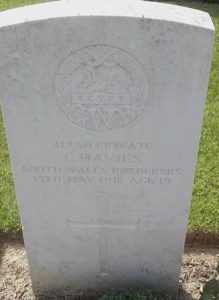
Edwin Davies, Private, 73719, Royal Welsh Fusiliers. Edwin was the son of Walter and Sinah Davies, of Pwynt, Llanfyllin. He enlisted into the Royal Welsh Fusiliers, and was drafted to France in the Spring of 1918, among a number of reinforcements for the 9th Battalion, Royal Welsh Fusiliers. The battalion was attached to 58 Brigade, 19th (Western) Division. The Division had wintered in the Cambrai sector, following the closure of the Battle of Cambrai, and was holding a section of the line in the Flesquières Salient. On 21 March 1918 the Germans launched the first of three offensives on to the section of the front running from Flesquières to St. Quentin, and the 19th Division was thrown into desperate fighting as it was pushed back over the coming days. The battered Division was then moved to the Messines sector to rest, but on 11 April became caught up in the second phase of the German offensive, which had been launched along the Lys Valley on 9 April, and again became caught up in desperate fighting. The remnants of the Division were moved south to the Aisne sector to rest and rebuild, but by sheer bad luck, the Germans third, and last, offensive was launched here on 27 May 1918, and the Division was once more caught up in desperate fighting. After being rebuilt once more, the Division moved north, and from 21 August 1918 took part in the great Allied offensive towards the Hindenburg Line, reaching Cambrai by 10 October. By the end of the month the Division had crossed the River Selle, and by the time of the Armistice was at Eth. Over the coming weeks the Division moved back to Cambrai, and then to the Candas area, as demobilisation started, and celebrated Christmas at Berteaucourt. Edwin unfortunately took ill, contracting influenza, and died on 11 February 1919. The 20-year-old is buried in Pont-Remy British Cemetery, France.
Evan Thomas Davies, Private, 291175, Royal Welsh Fusiliers. Evan was the son of Thomas and Ellen Davies, of Llechwedd, Llanfyllin. He worked as a farm labourer prior to the war. Evan enlisted into the 7th Battalion, Royal Welsh Fusiliers at Newtown on 1 November 1915, and was posted to Park Hall Camp, Oswestry, to join the 3/7th Battalion, Royal Welsh Fusiliers. On 3 July 1916 he embarked at Devonport for Egypt, landing at Alexandria ten days later, before being posted to the 1/7th Battalion, Royal Welsh Fusiliers, which was attached to 158 Brigade, 53rd (Welsh) Division. The Division had been evacuated from Gallipoli in December 1915, moving to Egypt to join the EEF, and helped guard the Suez Canal before taking part in operations to drive the Turks out of the Sinai. The EEF then turned its attention onto driving the Turks out of Palestine, and on 26 March 1917 launched its first offensive against the coastal city of Gaza, which guarded the road to Jerusalem. Initial gains during the day were lost when the assaulting divisions lost touch with each other and communication broke down when a thick fog cloaked the battlefield. Evan was taken prisoner by the Turks during the First Battle of Gaza, and was taken to a POW Camp in Turkey. He died as a POW in Haidar Pasha Hospital, Constantinople on 24 October 1917. News of the death of the 27-year-old was relayed by the Dutch Embassy to the army authorities, who then notified his parents. Evan is buried in Haidar Pasha Cemetery, Turkey.
Herbert Garston Davies, Private, 3988, The King’s (Liverpool Regiment). Herbert was born at Bradford, Lancashire in 1894, the son of Thomas Davies and Alice Rose Davies (nee Scott). His father was a fishmonger, from Llandysilio, and by 1898 the family had moved to Llanfyllin, where two of Herbert’s brothers were born. By the time war erupted, the family was residing at 55, High Street, Wavertree, Liverpool. Herbert enlisted under the name of Robert Davies into the 1/10th Battalion, King’s (Liverpool Regiment) in Liverpool on 9 November 1914. By then the battalion was at Tunbridge Wells, attached to the South Lancs. Brigade, West Lancs. Division, and on 2 November 1914 Herbert landed with the battalion at Le Havre. The battalion then moved to Bailleul where it was transferred to 9 Brigade, 3rd Division, before going into reserve to the Division at Westoutre. The Division took part in the famous Christmas Truce on 25 December 1914 and remained at Ypres throughout the winter. In 1915 the Division saw action at Bellewaarde and Hooge, and took part in the Second attack on Bellewaarde. On 6 January 1916, the 10th King’s transferred to 166 Brigade, 55th (West Lancs) Division. The Division was reformed in France during January 1916, and relieved the French 88th Division south of Arras. Relieved by the 11th (Northern) Division on 25 July, the Division moved south and took up a place in the front line opposite the village of Guillemont. By 1 August the 10th King’s moved into reserve positions at Talus Bois, remaining there until 7 August, when it received orders to prepare to launch an assault on Guillemont. On 8 August the battalion moved into position, and at dawn on 9 August 1916, launched a frontal assault on Guillemont. Casualties in the battalion were severe, with over 300 officers and men lost. Herbert was killed in action during the assault that day. The 22-year-old has no known grave and is commemorated on the Thiepval Memorial, France. One of his brothers, William Arthur Gordon Davies, was killed with the same battalion in 1918. Neither man is commemorated on the Llanfyllin war memorial.
John Edward Davies, Private, 41802, Royal Welsh Fusiliers. John was the son of Robert and Sinah Davies, of Aberhaiadr Cottage, Llanrhaiadr. He worked in Manchester as a warehouseman, and married Mary Katherine Thomas at Chorlton, Manchester on 2 December 1914. Mary was from Llanfyllin, and when John enlisted into the 21st Battalion, Royal Welsh Fusiliers on 10 July 1916, she moved back to 11, Market Street, Llanfyllin, with their young son, Thomas Berwyn Davies. John was drafted to France in December 1916, and was posted to the 11th Battalion, Royal Welsh Fusiliers. The battalion was in Salonika, attached to 67 Brigade, 22nd Division, so John entrained for Marseilles, sailing from there for Salonika aboard the HT Manitou on 30 December 1916. He was initially posted to the 2nd Entrenching Battalion for two months, before joining the ranks of the 11th RWF. During 24-25 April and 8-9 May 1917, the Division took part in two battles at Doiran, and then on 18 September 1918 launched an offensive, known as the Second Battle of Doiran. John was badly wounded during the assault of 18 September 1918, suffering gunshot wounds to his hand, leg and foot, and was taken aboard the Hospital Ship Glenearn Castle, before being brought to Cottonea Hospital, Malta. He died of his wounds in Cottonea on 22 October 1918. The 30-year-old is buried in Pieta Military Cemetery, Malta. John is not commemorated on the Llanfyllin war memorial, but is commemorated at Llanrhaeadr ym Mochnant.
William Arthur Gordon Davies, Private, 357816, The King’s (Liverpool Regiment). William was born at Llanfyllin in 1899, the son of Thomas Davies and Alice Rose Davies (nee Scott). His father was a fishmonger, from Llandysilio, and by 1898 the family had moved to Llanfyllin, where Herbert and another brother were born. By the time war erupted, the family was residing at 55, High Street, Wavertree, Liverpool. William enlisted at Liverpool into the Royal Field Artillery, but was later posted to France early in 1918, and transferred to the 1/10th Battalion, King’s (Liverpool) Regiment, which was in France attached to 166 Brigade, 55th (West Lancs) Division. The Division had faced the enemy counter attack at Cambrai on 30 November 1917, and was decimated. The battered Division was withdrawn from the area and sent to Bomy, near Fruges for intensive training, before relieving the 42nd (East Lancashire) Division in the front line at Givenchy and Festubert on 15 February. On 9 April the Germans launched the second phase of their Spring offensives in this sector, and the Division saw heavy fighting, taking part in the Battle of Éstaires, successfully fighting at the First Defence of Givenchy. The Division then fought at the Battle of Hazebrouck, before the area quietened down. On 24 August 1918 the Division successfully carried out a surprise attack that took and held the Givenchy craters. By the beginning of September, with the Allies on the offensive to the south, the Germans were found to have withdrawn from the Givenchy sector, and the Division then began to advance. William was wounded during the initial stages, and evacuated to hospital at Wimille, where he died of his wounds on 14 September 1918. The 18-year-old is buried in Terlincthun British Cemetery, Wimille, France. One of his brothers, Herbert Garston Davies, had been killed with the same battalion in 1916. Neither man is commemorated on the Llanfyllin war memorial.
Edward Edwards, Lance Corporal, 33434, Royal Welsh Fusiliers. Edward was the son of Edward and Ellen Edwards, of 14, Bridge Street, Llanfyllin. He worked as a boot repairer, and had moved to Newport, Shropshire by 1911. Edward married Emily Lily Dyas, of 20, Station Road, Newport, in the summer of 1915. Soon afterwards he received his call-up papers, so enlisted into the Royal Welsh Fusiliers at Shrewsbury on 3 September 1915. Edward was sent to the Barracks at Wrexham, before being posted to the 3rd Battalion, Royal Welsh Fusiliers at Litherland Camp, Liverpool, and after completing his training, embarked for France on 26 April 1916, joining the 2nd Battalion, Royal Welsh Fusiliers. The battalion was in the Cambrin Sector, attached to 19 Brigade, 33rd Division, and was holding a particularly notorious section of front line. On 20 March 1916 the 2nd RWF had moved back into the front lines at Cambrin to begin a routine tour in the trenches. The battalion carried out a successful trench raid on 2 April, before being relieved the following day, moving back to billets in Beuvry. On 7 April the battalion moved into the front line in the Auchy Left Sector, and the following day witnessed the blowing of an underground mine by the Royal Engineers, which they supported by sending out two raiding parties. This heralded a spell of horrific warfare for the battalion, with the Germans blowing their own mine the following day, and the conditions must have been terrible for the men, knowing they could be blown up at any time. This pattern continued over the coming weeks, and on 16 May 1916 the 2nd RWF moved into the front line again to undergo another short tour. Edward was one of two men killed on the following day, 17 May 1916. The 28-year-old is buried in Cambrin Churchyard Extension, France.
James Dennis Edwards, Private, 67317, Royal Army Medical Corps. James was born in Llanfyllin in 1897, the son of James Owen Edwards and Margaret Maud Edwards (nee Gibbins), of 5, Narrow Street, Llanfyllin. He lived at 15, Wellington Crescent, Welshpool prior to the war, where he worked as a Clerk. James enlisted at Liverpool into the 1/3rd (East Lancs) Field Ambulance, Royal Army Medical Corps on 6 September 1915 and was posted to Sheffield for training. After completing his training, he was posted to France, embarking at Southampton on 8 November 1915, before being attached to the 26th Siege Battery, Royal Garrison Artillery on 26 May 1916. By the summer of 1917 James had been attached to the 298th Siege Battery, RGA, which had landed in France on 1 April 1917. The battery had then moved to the Ypres Salient, setting up its guns near Belgian Chateau, in preparation to support the forthcoming Battle of Messines Ridge. Following the battle, on 31 July 1917 the Third Battle of Ypres opened, and the Battery moved its positions forward to cover the assault. James was killed in action at Ypres on 6 November 1917. The 20-year-old is buried in St. Julien Dressing Station Cemetery, Belgium.
Thomas John Edwards, Private, 796, Royal Welsh Fusiliers. Thomas was the son of George and Miriam Edwards, of Abel Yard, Llanfyllin. He enlisted into the 7th Battalion, Royal Welsh Fusiliers on 1 November 1912, and had attended the annual TA Summer Camp every year prior to the war. The battalion was a Territorial unit, which mobilised for war at Newtown in August 1914, as part of North Wales Brigade, Welsh Division and moved to Conway until the end of the month, before moving to Northampton. In December the Division moved to Cambridge and then in May 1915 to Bedford, where the Division was numbered and the formation became 158 Brigade, 53rd (Welsh) Division. Thomas did not embark with the battalion for Gallipoli, but remained in Britain with one of the reserve battalions. He did see overseas service at some time, as he was awarded the British War and Victory Medals. Thomas took ill in 1916, and on 28 June 1916 was discharged from the army after having been diagnosed as suffering from tuberculosis. He died of tuberculosis at home on 9 May 1919. The 23-year-old was buried in Llanfyllin Cemetery three days later.
William Henry Edwards, Private, 40396, Royal Welsh Fusiliers. William was the son of David and Mary Edwards, of Church View, Llanfyllin. He worked as a coal dealer prior to the war. He enlisted at Llanfyllin into the Royal Welsh Fusiliers, and after completing his training was posted to France in the summer of 1916, joining the 1st Battalion, Royal Welsh Fusiliers, which was on the Somme, attached to 22 Brigade, 7th Division. The Division had taken part in the opening assault of the Somme offensive on 1 July 1916, advancing from positions near Bois Francais, near Fricourt, and capturing the village of Mametz, one of the few successes of 1 July 1916. William was possibly among 38 men who arrived to reinforce the 1st RWF on 2 July. The battalion then took part in further attacks to push forwards, to the south of Mametz Wood, and upon being relieved, witnessed the troops of the 38th (Welsh) Division moving forward to launch its assault on Mametz Wood. On 14 July, with the wood taken, the 7th Division moved back into the line, with orders to capture Bazentin-le-Petit, before taking part in the terrible attacks on High Wood over the coming days. On 22 July the 1st RWF was relieved, moving back into reserve to rest and rebuild at La Chaussee. By 12 August the battalion had moved forwards to Dernancourt, and on 26 August marched further forward, to take part in the Divisions assault on Ginchy. The Division saw heavy fighting over the coming days, before the 1st RWF had another short break, but on 1 September the battalion received orders to push forwards again to launch a fresh assault on Ginchy from Montauban Alley. On 3 September 1916 the 1st RWF launched its assault, but suffered severe casualties, with over 200 officers and men killed, wounded or missing. William had been killed in action during the attack that day. The 28-year-old has no known grave, and is commemorated on the Thiepval Memorial, France.
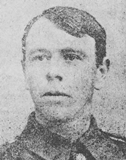
David Evans, Private, 290784, Royal Welsh Fusiliers. David was the son of William and Eliza Evans, of Garthgell, Llanfyllin. He enlisted at Welshpool into the 7th Battalion, Royal Welsh Fusiliers on 27 October 1914. The battalion was a Territorial unit, which mobilised for war at Newtown in August 1914, as part of North Wales Brigade, Welsh Division and moved to Conway until the end of the month, before moving to Northampton. In December the Division moved to Cambridge and then in May 1915 to Bedford, where the Division was numbered and the formation became 158 Brigade, 53rd (Welsh) Division. On 19 July 1915 the entire Division sailed from Devonport for Imbros and on 9 August 1915 landed at Suvla Bay. The infantry moved off the beaches into the bush, but due to a lack of maps and no knowledge of the terrain, many of the units became disorientated, and the situation became chaotic. The Division was eventually evacuated from Gallipoli in December 1915, moving to Egypt to join the EEF, and helped guard the Suez Canal before taking part in operations to drive the Turks out of the Sinai. The EEF then turned its attention onto driving the Turks out of Palestine, and on 26 March 1917 launched its first offensive against the coastal city of Gaza, which guarded the road to Jerusalem. Initial gains during the day were lost when the assaulting divisions lost touch with each other and communication broke down when a thick fog cloaked the battlefield. David was shot in the side during the battle, and spent several weeks in hospital before re-joining the 7th RWF on 23 May. By then a second attempt to force Gaza had been launched on 17 April, which also failed, and the EEF suffered a change in leadership, with Sir Edmund Allenby assuming command, before being re-organised, and a third offensive was launched against a wider front from Beersheba to Gaza on 31 October 1917. This time the Turkish defences were breached, and the road to Jerusalem now lay open and the EEF began to advance north. On 6 November 1917, 158 Brigade launched an attack on the Khuweilfeh Heights. David was wounded again during the attack, and spent several weeks in hospital before re-joining the battalion on 2 January 1918. On 29 March 1918 he was wounded for a third time, and returned to England after receiving treatment at Alexandria. David was posted to the 7th RWF Depot, where he saw out the end of the war. After the Armistice, he was granted two weeks leave, and returned home to Llanfyllin. David’s health had been shattered by his multiple wounds, and he fell ill soon after returning home, before falling into a coma, and died on 2 December 1918. The 27-year-old is buried in Llanfyllin Cemetery.
Edward Evans, Sergeant, 5519, Wiltshire Regiment. Edward was born in 1879, the son of Thomas and Mary Evans. Two years later, the family were living back in their native Llanfyllin. Edward had moved to 22, Stuart Street, Treorchy as a young man, and worked as a coal miner. He married Mary Catherine Jones in 1908, and the couple had two children. Edward was probably an army reservist, who re-enlisted into the 1st Battalion, Wiltshire Regiment in London soon after the outbreak of war. The battalion was at Tidworth, attached to 7 Brigade, 3rd Division, and on 14 August 1914 Edward landed at Rouen with the battalion. The 3rd Division then moved to the Belgian Frontier, taking part in the opening Battle of Mons, and in the epic retreat, from the Rearguard Action of Solesmes, through the Battle of Le Cateau, and down to the Marne, where the German Offensive was stopped. The Division followed the German withdrawal to the Aisne, where they met them in battle, and stopped the advance on Paris. The Division then moved north to Flanders, and took part in the Battle of La Bassée, and at the Battle of Messines, which were a prelude to the First Battle of Ypres. The Division took part in the famous Christmas Truce on 25 December 1914 and remained at Ypres throughout the winter. In 1915 the Division saw action at Bellewaarde and Hooge, and took part in the Second attack on Bellewaarde. Edward must have been invalided home at some time, as he was later posted to the 5th Battalion, Wiltshire Regiment. The battalion was attached to 40 Brigade, 13th (Western) Division, and had taken part in the Gallipoli campaign, before being evacuated to Egypt in January 1916, and the following month was diverted to Mesopotamia, to take part in the attempt to relieve the besieged garrison at Kut. Edward was wounded soon after, during the failed attempt to rescue General Townshend’s garrison, and died of his wounds on 30 March 1917. The 38-year-old is buried in Baghdad (North Gate) War Cemetery, Iraq.
John Evans, MM, Sergeant, 23156, South Wales Borderers. John was the son of Evan and Annie Evans, of Godor Farm, Llanfyllin. Some years prior to the war he had moved to 78 Queen Road, Tredegar, where he worked as a coal hauler. John enlisted at Newport into the 10th Battalion, South Wales Borderers soon after the outbreak of war. The battalion had been raised at Brecon by the Welsh National Executive Committee in October 1914, moving to Colwyn Bay to join 130 Brigade, 43rd (Welsh) Division. On 29 April 1915, the formation became 115 Brigade, 38th (Welsh) Division, moving to Hursley Park, Winchester then Hazeley Down. On 4 December 1915 John landed in France with the battalion, which proceeded to the Nursery Sector near Fleurbaix for trench initiation alongside the Guards Division. The Division then held a sector of the line near Cuinchy before marching south to the Somme sector in June 1916 to take part in the assault on Mametz Wood. The first attack on the wood was launched on a two-battalion front on 7 July, but failed, and the Divisional Commander, Sir Ivor Philipps, was replaced before the Division attacked again on a two Brigade front on 10 July 1916. After two days of ferocious hand-to-hand fighting, the wood was cleared up to its northern edge, before the battered Division was relieved. It then took over a section of the front at Hébuterne before moving to the Ypres Salient, and taking over the Canal Bank sector at Boesinghe. The infantry battalions of the Division then began carrying out the normal pattern of rotation in the trenches, four days in the front, four in support and four in reserve, whilst also working on trench improvement, digging new trenches, and also carrying out regular patrols and trench raids. John must have been invalided at some time, as he transferred to the 2nd Battalion, South Wales Borderers, which was attached to 87 Brigade, 29th Division. The 29th Division had also seen heavy fighting on the Somme, suffering severe casualties during its assault on Y-Ravine on 1 July 1916. During the Spring of 1917 it was in the Arras sector, and saw heavy fighting at the Battle of the Scarpe, which was part of the Arras Offensive. The Division then moved further north to Ypres, relieving the 38th (Welsh) Division, and was thrown into terrible fighting during the Battle of Langemarck. The Division saw further fighting at Ypres, at the Battle of the Menin Road, and then at Polygon Wood, Broodeseinde and Poelcapelle. John had been awarded the Military Medal for his bravery during the Third Battle of Ypres, and the award was published in the London Gazette of 18 October 1917. The Division then moved south to Cambrai, to join the Battle of Cambrai in November and December 1917 before moving back to Flanders early in 1918, and began work on the Gravenstafel Line. On 3 February 1918 the 2nd SWB moved into the front line at the Goudberg Spur, and on 5 February 1918 was at work improving the line when John was mortally wounded, dying that same day. The 34-year-old is buried in Oxford Road Cemetery, Belgium. John is not commemorated on the Llanfyllin war memorial.
John Charles Evans, Leading Seaman, J/11625, Royal Navy. John was born at Llanfyllin on 5 November 1894, the son of Robert Charles Evans and Margaret Evans. He had left home as a young man, and enlisted into the Royal Navy on 5 November 1912. John married Annie Riley, of 25, Warwick Road, Wallsend-on-Tyne in the summer of 1916. By now he was serving aboard the destroyer HMS Marmion. The vessel was initially deployed as part of the Grand Fleet, before undertaking escort duties. In October 1917, Marmion was one of eight destroyers that were escorting convoys between Shetland and Norway. On 20 October, Marmion was sent to escort an outbound convoy heading for Bergen, and was en-route on 21 October 1917 when HMS Tirade, part of another Convoy group, collided with her in heavy seas, and Marmion sunk with all hands. The 20-year-old John went down with the ship. He has no known grave and is commemorated on the Plymouth Naval Memorial, Devon. John is not commemorated on the Llanfyllin war memorial.
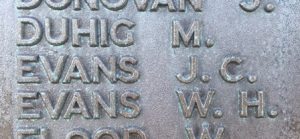
Richard Maurice Evans, Corporal, 15089, Royal Welsh Fusiliers. Richard was born in London in 1887, the son of Richard and Anne Elizabeth Evans. By 1893 the family was residing at 3, Narrow Street, Llanfyllin. Richard had emigrated to Canada prior to the war, but returned following the outbreak of war, arriving at Liverpool aboard the SS Empress of Britain on 15 August 1914, and enlisted at Colwyn Bay into the 10th Battalion, Royal Welsh Fusiliers. The battalion formed at Wrexham on 16 September 1914, before joining 76 Brigade, 25th Division at Codford St. Mary, Salisbury Plain. On 27 September 1915 the battalion landed at Boulogne, and the entire Division moved to Bailleul, before moving into the Ypres Salient, taking over a section of the front line by 15 October. The 10th RWF then began the usual routine of trench rotation, normally four days in the front line, four in support and four in reserve. On 4 December 1915 the battalion moved into the front-line trenches to begin a routine tour in the line, relieving the 2nd Suffolk’s. Richard was killed in action during this relatively quiet spell, on 9 December 1915. The 28-year-old is buried in Hedge Row Trench Cemetery, Belgium.
Thomas Alfred Evans, Private, TR4/67343, South Wales Borderers. Thomas was the son of Joseph Evans and Elizabeth Evans (nee Jones), of New Mills, Llanfyllin. Following the death of their parents, Thomas and his two sisters were raised by their Aunt and Uncle, David and Annie Evans, at Bodyddan Isa, Llanfyllin. Thomas enlisted into the 53rd Battalion, Training Reserve in 1918, and was posted to Kinmel Park for training. He was then transferred to the 419th Agricultural Company, Labour Corps, and was put on farm work. Thomas became ill early in 1919, and was sent to Chester War Hospital, where he was found to have an intestinal obstruction. He died as a result of his illness on 27 April 1919. The remains of the 18-year-old were brought home for burial in Llanfyllin Cemetery.
Thomas John Evans, Private, 3188, Royal Welsh Fusiliers. Thomas was the son of Evan Thomas Evans and Ellen Ann Evans, of The Cottage, Pen-y-Bont Fawr. He lived at Glanfeiglo, Llanfyllin prior to the war. Thomas enlisted at Welshpool into the 7th Battalion, Royal Welsh Fusiliers soon after the outbreak of war. The battalion was a Territorial unit, which mobilised for war at Newtown in August 1914, as part of North Wales Brigade, Welsh Division and moved to Conway until the end of the month, before moving to Northampton. In December the Division moved to Cambridge and then in May 1915 to Bedford, where the Division was numbered and the formation became 158 Brigade, 53rd (Welsh) Division. On 19 July 1915 the entire Division sailed from Devonport for Imbros and on 9 August 1915 landed at Suvla Bay. The infantry moved off the beaches into the bush, but due to a lack of maps and no knowledge of the terrain, many of the units became disorientated, and the situation became chaotic. Thomas was killed in action on the following day, 10 August 1915. The 30-year-old has no known grave and is commemorated on the Helles Memorial, Gallipoli.
Edward Hall, Lance Corporal, 35001, Yorkshire Regiment (Green Howards). Edward was born at Wem in 1889, the son of Joseph and Agnes Hall. Soon afterwards, the family came to live at 20, New Road, Llanfyllin. Edward worked as a Clerk at Llanfyllin prior to the war. He enlisted at Llanfyllin into the 7th Battalion, Royal Welsh Fusiliers, and was posted to one of the reserve battalions, probably the 2/7th RWF. Edward married Clara Elizabeth Clarke at St. Albans in 1916, and Clara then moved to Llanfyllin. Edward was posted to France in the winter of 1917-18, and was transferred to the 13th Battalion, Yorkshire Regiment (Green Howards). The battalion had been in France since 6 June 1916, attached to 121 Brigade, 40th (Bantam) Division, and had seen heavy fighting at the assault on Bourlon Wood in November 1917. Edward probably joined the battalion among a number of drafts after the assault. The Division remained in the area over the winter, holding the line near Mory, and on 21 March 1918 was among those Divisions hit hard when the Germans launched the first phase of their Spring Offensive, along the section of front running from Croisilles to La Fère. The 40th Division dug in to the east of St. Leger, but was forced to withdraw along with the adjoining Divisions over the coming days, suffering heavy casualties, reaching Bienvillers by 27 March, before being relieved. The Division then transferred north, moving to the Merville sector, to rest and rebuild. Unfortunately, on 9 April 1918 the Germans launched the second phase of their Spring Offensive along the Lys Valley, and the Division, at Neuf-Berquin, became caught up in terrible fighting once more. The 13th Yorkshires were holding the line at Bois Grenier when the Germans struck, and were forced wo withdraw. Edward was wounded during the early days of the offensive. He died of his wounds on 12 April 1918. The 29-year-old has no known grave and is commemorated on the Ploegsteert Memorial, Belgium.
Robert Harris, Sapper, 151399, Royal Engineers. Robert was the son of Elizabeth Harris, of Llanfyllin. He lived at 25, Barrett Street, Cwmpark, Rhondda prior to the war, where he worked as a coalminer. Robert enlisted at Pentre into the 10th Battalion, Devonshire Regiment soon after the outbreak of war. The battalion was formed at Exeter, before moving to Stockton Camp, Salisbury Plain, to join 79 Brigade, 26th Division. On 23 September 1915 Robert landed in France with the battalion, and the entire 26th Division moved to Guignemicourt, west of Amiens. Soon afterwards the Division was sent to Salonika, but Robert remained in France, transferring to the 253rd Tunnelling Company, Royal Engineers. The Company comprised of a large number of South Wales miners, as did several others, and formed in January 1916, moving to Sailly Labourse and the front-line areas of the old Loos battlefield, north of the Vermelles-Hulluch road, and began mining work. Robert was at work in an underground gallery on 18 June 1916, erecting timber roof supports, when the Germans blew a counter-mine, and he was killed when the roof fell on him. The remains of the 41-year-old were dug-out, and he was buried in Vermelles British Cemetery, France.
Thomas Derfel Hughes, Second Lieutenant, Oxford and Bucks Light Infantry. Thomas was the son of Owen Hughes and Sarah Hughes (nee Hamer), of Pendry, Llanfyllin. He was commissioned into the Oxfordshire and Buckinghamshire Light Infantry on 3 October 1915, and embarked for France, joining the 4th Battalion, Oxfordshire and Buckinghamshire Light Infantry. The battalion was attached to 145 Brigade, 48th (South Midland) Division, and was billeted in Courcelles when Thomas arrived. The Division was holding a section of the line at Hébuterne, at the northern extreme of the Somme sector. On 2 May 1916 the 4th Ox & Bucks LI moved into the front line to begin a routine tour. The night was peaceful, but on the following morning, 3 May 1916, the Germans shelled the battalions’ positions, with a variety of heavy guns and trench mortars. Thomas and another officer, Second Lieutenant King, were killed by the same shell, while several other men were also killed. Thomas was 19-years-old when he was killed that day, and is buried in Hébuterne Military Cemetery, France.
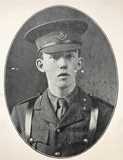
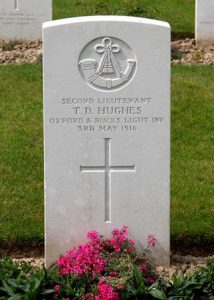
Arthur Wynn Jones, Lance Corporal, 2352, Welsh Regiment. Arthur was born at The Hall, Llanfyllin on 23 March 1880, the son of Thomas Jones and Elizabeth Alice Jones (nee Edwards). He was educated at Oswestry Grammar School, before gaining a position at the National Provincial Bank, first at their Horsefield Branch, in Bristol, and then at Cowbridge, Glamorgan. Arthur enlisted into the 5th Battalion, Welsh Regiment soon after the outbreak of war. The battalion was a Territorial Army unit, which mobilised at Pontypridd following the outbreak of war, as part of South Wales Brigade. The battalion initially moved to its war station at Pembroke Dock, before entraining for Tunbridge Wells, and in February 1915 moved to Scotland on the Forth and Tay Defences. On 17 April 1915 the battalion joined 159 Brigade, 53rd (Welsh) Division at Bedford, and on 19 July 1915 the Division sailed from Devonport for Mudros, arriving on 5 August. On 9 August the Division landed at Suvla Bay. The infantry moved off the beaches into the bush, but due to a lack of maps and no knowledge of the terrain, many of the units became disorientated, and the situation became chaotic. Arthur was killed in action on the following day, 10 August 1915. The 35-year-old has no known grave and is commemorated on the Helles Memorial, Gallipoli. He is also commemorated on the Cowbridge war memorial.
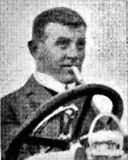
Bertie Jones, Private, 275693, Manchester Regiment. Bertie was the son of Richard and Sarah Elizabeth Jones, of Penybryn, Llanfyllin. By 1911 he was living at 54, Birch Lane, Longsight, Manchester, where he worked as an assistant building inspector. Bertie later lived at Westbury, Crowborough, Sussex, and married Emma Rivers there in 1916. He had enlisted at Manchester into the 7th Battalion, Manchester Regiment, and in the summer of 1917, was posted out to France, joining the 1/7th Battalion, Manchester Regiment, which was attached to 127 Brigade, 42nd (East Lancashire) Division. The Division had taken part in the Gallipoli campaign, before evacuation to Egypt, and had moved to France in March 1917, taking over the line near Épehy then Havrincourt. In September the Division moved north to Ypres, and fought throughout Third Ypres, until moving to the Coast in September to refit. November 1917 saw the Division moving to positions at Givenchy, where it remained until moving back south in early 1918. Here the Division faced the German Spring Offensive of 21 March on the Somme, and saw heavy fighting as it was forced to withdraw. The offensive stalled for several months, until an Australian victory at Villers Bretonneux on 8 August saw the tide of war turn. The British attacked the German lines on the Somme on 21 August 1918 and the 42nd Division took part in the great offensive which followed. On 21 September the 1/7th Manchester’s moved into the reserve line east of Havrincourt Wood and five days later received its orders to take part in another assault on the following day. At 05.20 on 27 September 1918 the battalion launched its assault against the Hindenburg Line, meeting with stiff resistance. Over 200 casualties were suffered by the battalion during the fighting that day, including Bertie, who had been killed. The 30-year-old has no known grave and is commemorated on the Vis-en-Artois Memorial, France.
David Richard Jones, Gunner, 150584, Royal Garrison Artillery. David was born at Rock Ferry, Cheshire in 1898, the son of David and Martha Jones. His parents were both from Llanfyllin, and by 1911 the family had moved back there, to live at 28, Bridge Street, Llanfyllin. David worked as a cleaner for the Cambrian Railways prior to the war. He enlisted at Welshpool into the Royal Garrison Artillery, and was posted to the 126th Siege Battery, RGA. David embarked for France with the battery in July 1916, and the battery moved to Doullens, in the Somme sector. By 5 August the Battery had set its guns up near Mametz, and began work supporting the great Somme offensive. In February 1917 the battery moved out of the Somme, and headed north to the Louez sector, where it supported the Canadian assault on Vimy Ridge. The battery then moved to Neuville St. Vaast, and supported the Arras offensive. During May 1917 the battery moved further north, into the Ypres Salient, setting its guns up at Kemmel, and supported the assault on Messines Ridge. In July the battery moved north again, to the Ypres Canal Bank sector, and supported the troops taking part in the opening assault of the Third Battle of Ypres. David took ill whilst the battery was still in the Ypres Salient, and was invalided back to England, before being sent to the 4th Scottish General Hospital, in Glasgow. He died there of nephritis on 16 November 1917. The remains of the 19-year-old were brought home for burial in Llanfyllin Cemetery.
Evan Thomas Jones, Private, 291390, Royal Welsh Fusiliers. Evan was the son of Thomas and Ann Jones, of 24, High Street, Llanfyllin. He worked as a cowman at Llanrhaiadr prior to the war. Evan enlisted into the 7th Battalion, Royal Welsh Fusiliers at Llanfyllin on 11 December 1915, and was posted to the 3/7th Battalion, Royal Welsh Fusiliers at Park Hall Camp, Oswestry for training. He embarked for Egypt at Devonport on 3 July 1916, and after disembarking at Alexandria ten days later, was posted to the 1/7th Battalion, Royal Welsh Fusiliers, which was attached to 158 Brigade, 53rd (Welsh) Division. The Division had been evacuated from Gallipoli in December 1915, moving to Egypt to join the EEF, and helped guard the Suez Canal before taking part in operations to drive the Turks out of the Sinai. The EEF then turned its attention onto driving the Turks out of Palestine, and on 26 March 1917 launched its first offensive against the coastal city of Gaza, which guarded the road to Jerusalem. Initial gains during the day were lost when the assaulting divisions lost touch with each other and communication broke down when a thick fog cloaked the battlefield. Evan was killed in action during the fighting that day. The 24-year-old has no known grave and is commemorated on the Jerusalem Memorial, Israel.
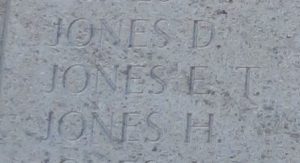
Joseph Evan Jones, Fireman and Trimmer, Mercantile Marine. Joseph was the son of Henry Jones and Margaret Jones (nee Roberts), of Llanfyllin. By 1901 he was living at Liverpool, and he joined the Mercantile Marine soon afterwards. During the war, Joseph was serving aboard the Glasgow registered steamship, SS Ardendearg. On 14 March 1918, Ardendearg was sailing near Malta, when she was torpedoed and sunk by the German submarine, UC-54. Joseph was 34-years-old when he was drowned in the sinking, and is commemorated on the Tower Hill Memorial, London. Joseph is not commemorated on the Llanfyllin war memorial.
William Gordon Jones, Private, 85385, Durham Light Infantry. William was born at Rhayader on 12 February 1899, the son of William and Annie Jones. Prior to the war the family was residing at Coed Howell, Llanfyllin, and William was still in school when war erupted. He enlisted into the 3rd Battalion, Royal Welsh Fusiliers at Welshpool on 10 November 1917, and after completing his training, embarked for France on 31 March 1918, just ten days after the Germans had launched the first phase of their Spring Offensive on the Somme. William joined the Infantry Base Depot before being transferred to the 1/6th Battalion, Durham Light Infantry, joining the battalion on 19 April 1918. The battalion was attached to 151 Brigade, 50th (Northumbrian) Division, and was in the Lys valley, fighting a desperate rear-guard action following the launching of the second phase of the German offensive there on 9 April. The battered Division was then transferred to the Aisne sector to rest and rebuild, but unfortunately on 27 May 1918 the Germans launched the third, and last, phase of their Spring Offensive here and the 50th Division was again caught up in desperate fighting. William’s battalion was in positions near the Bois Marais when the Germans launched their offensive along the section of front stretching from Soissons to Reims and was hit at dawn. Desperate fighting raged over the coming days as the Allies were driven back, and William was posted as missing at some time between 27 and 31 May 1918. He was later found to have been taken prisoner of war by the Germans, and was brought to a POW Camp in Poland. As happened so often in captivity, due to extreme food shortages in Germany at the time, William’s health suffered, and he died of bronchial catarrh and heart failure at Heilsberg Hospital on 30 October 1918, aged 18. He is buried in Lidzbark Warminski War Cemetery, Poland.
Robert Rhys Lloyd, Staff Sergeant, A/2794, Royal Army Ordnance Corps. Robert, known as Bobbie, was born in Gravesend on 16 October 1882, the son of John and Jane Lloyd. By 1891 he was residing with his grandparents, Robert and Elizabeth Lloyd, at the Schoolhouse, Garthbeibio, while his mother had remarried, and was living at Hen Ysgol, Llangynog. Robert lived at 25, High Street, Llanfyllin prior to the war, and worked as a jeweller and watch repairer. He enlisted into the Royal Army Ordnance Corps, and was posted to Mesopotamia. Robert remained with the forces in Mesopotamia after the Armistice, and died of disease in Basra on 1 December 1919. The 37-year-old is buried in Basra War Cemetery, Iraq.
Robert Morris, Private, 55472, Royal Welsh Fusiliers. Robert was the son of John and Mary Morris, of Pantyffynon, Ty Crwyn, Llanfyllin. He worked on his parent’s farm prior to the war. Robert enlisted into the Montgomeryshire Yeomanry at Llanfyllin soon after the outbreak of war. He was probably posted to Park Hall Camp, Oswestry for training, before being drafted to France in the winter of 1916-17, and posted to the 17th Battalion, Royal Welsh Fusiliers, which was attached to 115 Brigade, 38th (Welsh) Division. The Division had moved to the Ypres Salient following its famous assault on Mametz Wood in July 1916, and took over the Canal Bank sector at Boesinghe. The infantry battalions of the Division then began carrying out the normal pattern of rotation in the trenches, four days in the front, four in support and four in reserve, whilst also working on trench improvement, digging new trenches, and also carrying out regular patrols and trench raids. On 31 July 1917 the Division launched its famous assault on the Pilckem Ridge, capturing Iron Cross and reaching its objective of the Steenbeek, then played a supporting role in the Battle of Langemarck. The Division was transferred to the Sailly-sur-la-Lys sector in September, and remained in the area over the winter. At the beginning of March 1918, the 17th RWF was at Wez Macquart, having relieved the 2nd RWF on 1 March to begin a routine tour in the trenches. Robert drowned whilst on a working party here on 3 March 1918. The 32-year-old is buried in Erquinghem-Lys Churchyard Extension, France.
Herbert Evans Price, Private, 38614, King’s Shropshire Light Infantry. Herbert was born in Kerry in 1899, the son of John Smith Price and Annie Price (nee Evans). By 1911 the family had moved to Derlwyn House, Llanfyllin. Herbert enlisted at Llanfyllin into the Training Reserve, and after completing his training was posted out to France at some time in 1918, joining the 7th Battalion, King’s Shropshire Light Infantry, which was attached to 76 Brigade, 3rd Division. The Division had been caught up in desperate fighting following the launching of the German Spring offensives, taking part in the initial fighting of 21 March and suffered heavy casualties before being moved to Flanders to rest, becoming caught up in the second phase of the German offensive on the Lys from 9 April onwards. The Division remained in the Locon sector after the fighting had moved south, to the Aisne sector, in May, enjoying a relatively peaceful time over the coming months. Herbert would have arrived at some time during this more peaceful period. By August 1918 the Division was in position in the Arras sector, ready to take part in the great Allied offensive, which was launched on 21 August. The 7th KSLI assembled at Monchy au Bois on 20 August, and the following morning launched their part of the great advance, taking Courcelles during the day. The battalion was counter-attacked on the following day, but beat the Germans off. On 23 August the 7th KSLI launched an attack against a series of strong-points along the railway embankment east of Courcelles. Herbert was killed in action during the fighting that day. The 18-year-old has no known grave and is commemorated on the Vis-en-Artois Memorial, Haucourt, France.
William Herbert Prosser, Private, 278, Royal Welsh Fusiliers. William was born at Llanfyllin in 1884, the son of Thomas Prosser and Mary Prosser (nee Dearden). The family later resided at 34, Canal Road, Newtown. William worked as a labourer for Newtown Council, and had served with the 5th Volunteer Battalion, South Wales Borderers for several years before enlisting into the 7th Battalion, Royal Welsh Fusiliers on 30 June 1908. The battalion was a Territorial Army unit, and William attended the annual summer TA camps at Abergavenny, Bow Street, Lamphey, Carnarvon, Rhyl and Aberystwyth over the coming years. The battalion mobilised for war at Newtown in August 1914, as part of North Wales Brigade, Welsh Division and moved to Conway until the end of the month, before moving to Northampton. In December the Division moved to Cambridge, where William was found to be unfit for further military service, due to an old injury to his ankle, and he was discharged as medically unfit on 29 March 1915. He returned home to Newtown, where married Maud Jones in 1916, and the couple lived at 39, Ladywell Street, Newtown. William died on 17 October 1918. The 34-year-old was buried in St. David’s Churchyard, Newtown. William is commemorated on the Newtown war memorial, but not at his native Llanfyllin.
Milton Mial Richards, Private, 31467, South Wales Borderers. Milton was the son of John and Sarah Richards, of Bronhaul, Bwlchyddan, Llangedwyn. He enlisted into the army at Wrexham, and after completing his training was posted to France in the late summer of 1917, joining the 10th Battalion, South Wales Borderers, which was attached to 115 Brigade, 38th (Welsh) Division. Milton probably joined the battalion after its epic assault on the Pilckem Ridge on 31 July 1917. The Division was transferred to the Sailly-sur-la-Lys sector in September, and remained in the area over the winter before being moved to positions north of Albert, at Bouzincourt Ridge, at the end of March 1918, relieving the battered 2nd and 47th Divisions. It held this sector, again carrying out minor operations and trench raids, over the coming months, before taking part in the great offensive of 21 August 1918, and began its advance towards the Hindenburg Line. Over the coming days the Division advanced across the old Somme battlefield of 1916, recapturing Thiepval, Pozieres, Mametz Wood and Bazentin, before taking Longueval and Delville Wood. By 31 August the Division was held up in front of Lesboeufs, but on the following day the 2nd RWF and 17th RWF of 115 Brigade attacked and captured the ruined village, with the 10th SWB in support. Milton was killed in action on the following day, 2 September 1918, whilst the 10th SWB was advancing to a line near Sailly-Saillisel. The 20-year-old has no known grave and is commemorated on the Vis-en-Artois Memorial, Haucourt, France.
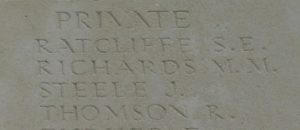
John William Roberts, Second Lieutenant, Royal Welsh Fusiliers. John was the son of Joseph and Ann Roberts, of Pant Farm, Llanfyllin. He enlisted into the 7th Battalion, Royal Welsh Fusiliers soon after the outbreak of war, and was posted to one of the reserve battalions. John was commissioned as Second Lieutenant into the battalion on 23 August 1917, and was posted to France, joining the 1/4th Battalion, Royal Welsh Fusiliers, which was the Pioneer Battalion to the 47th (2nd London) Division. John joined the battalion near Arras, where the Division was holding a section of the Flesquières Salient. The Division had seen heavy fighting during the Battle of Cambrai, and remained in the sector over the winter of 1917-18. On 20 March 1918 the 4th RWF was in billets at Lechelles, awaiting orders to relieve the 2nd Division Pioneers. The weather was atrocious, so the relief was delayed. At dawn on the following day, 21 March 1918, the Germans launched an overwhelming assault along a section of the Western Front running from Croisilles to La Fère, and broke through in several places. The 4th RWF received orders to Stand To, and be ready to move, before receiving orders to advance and take over the Metz Defences. John was wounded by shrapnel from a German artillery shell soon afterwards, and died of his wounds two days later, on 23 March 1918. The 27-year-old has no known grave and is commemorated on the Arras Memorial, France.
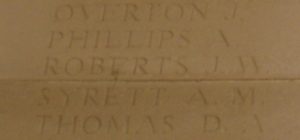
Thomas Roberts, Private, 291289, Royal Welsh Fusiliers. Thomas was the son of Robert and Elizabeth Roberts, of Bwlchygraig, Llanfyllin. He worked on his parent’s farm prior to the war. Thomas enlisted into the 7th Battalion, Royal Welsh Fusiliers at Welshpool on 27 November 1915, and was posted to the 3/7th Battalion, Royal Welsh Fusiliers at Park Hall Camp, Oswestry. He embarked for Egypt on 30 May 1916, joining the 1/7th Battalion, Royal Welsh Fusiliers, which was attached to 158 Brigade, 53rd (Welsh) Division. The Division had been evacuated from Gallipoli in December 1915, moving to Egypt to join the EEF, and helped guard the Suez Canal before taking part in operations to drive the Turks out of the Sinai. The EEF then turned its attention onto driving the Turks out of Palestine, and on 26 March 1917 launched its first offensive against the coastal city of Gaza, which guarded the road to Jerusalem. Initial gains during the day were lost when the assaulting divisions lost touch with each other and communication broke down when a thick fog cloaked the battlefield. A second attempt to force Gaza was launched on 17 April, which also failed, and the EEF suffered a change in leadership, with Sir Edmund Allenby assuming command, before being re-organised, and a third offensive was launched against a wider front from Beersheba to Gaza on 31 October 1917. This time the Turkish defences were breached, and the road to Jerusalem now lay open and the EEF began to advance north. On 6 November 1917, 158 Brigade launched an attack on the Khuweilfeh Heights. Thomas was killed in action during the assault that day. The 23-year-old has no known grave and is commemorated on the Jerusalem Memorial, Israel. Thomas is not commemorated on the Llanfyllin war memorial.
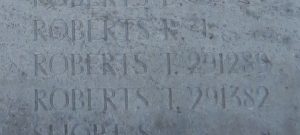
Thomas Edward Rowlands, Private, 355465, Royal Welsh Fusiliers. Thomas was the son of Maurice and Mary Rowlands, of 3, Waenllys, Llanfyllin. He worked as a railway porter prior to the war. Thomas enlisted at Llanfyllin into the Montgomeryshire Yeomanry on 10 December 1915, and was initially placed on the Army Reserve, He was mobilised on 24 January 1916, travelling to Wrexham for his medical. Thomas embarked for Egypt at Devonport on 12 January 1917, and upon disembarking, was posted to the 1/1st Battalion, Montgomeryshire Yeomanry. On 4 March 1917 the battalion merged with the Welsh Horse Yeomanry to form the 25th (Montgomery & Welsh Horse Yeomanry) Battalion, Royal Welsh Fusiliers, as part of the newly formed 231 Brigade, 74th (Yeomanry) Division. The Division assembled in Egypt as part of the EEF, before crossing the Suez Canal into the Sinai, and saw its first major action during the Second Battle of Gaza. The battle was a failure, and the EEF was re-organised under a new commander, Sir Edmund Allenby, before launching the Third Battle of Gaza on the night of 31 October 1917. This assault was launched along a winder front, running from Gaza to Beersheba, and this time the EEF prevailed, opening the door to Jerusalem. The Division then took part in the drive north into Syria, but as a result of the heavy losses suffered in France, following the launching of the three German Spring offensives from 21 March 1918, was sent to France, landing in Marseilles on 7 May 1918. The Division underwent a system of training, to prepare it for the vastly different conditions on the Western Front, before taking over a section of the front in the St. Floris Sector. On 10 July 1918 the 25th RWF moved into the front line here for the first time, in the right subsector, covering St. Venant, for a long tour. Thomas was one of three men killed by enemy shellfire whilst in the line on 20 July 1918. The 21-year-old is buried in St. Venant-Robecq Road British Cemetery, Robecq, France.
Arthur James Sivell, Sergeant, 26175, Wiltshire Regiment. Arthur was the son of Jacob and Hannah Sivell, of 13, Estcourt Crescent, Devizes. He married Lilian Jesse at St. Mark’s, Dalston on 1 January 1908, and the couple set up home at The Hollies, Felstead, Essex, where Arthur worked as a gymnastic instructor. Arthur enlisted at Braintree into the Wiltshire Regiment, and was posted to France at some time in 1916, joining the 1st Battalion, Wiltshire Regiment, which was attached to 7 Brigade, 25th Division. His wife, Lilian, then moved to 6, Rhiwlas Terrace, Llanfyllin with their three children. The Division had landed in France on 26 September 1915, and moved to the Vimy area. It then moved to the Warloy area and attacked on 3 July 1916 near Thiepval. The Division fought throughout the Battle of the Somme, and then moved to Ploegsteert, where it held the line for the months leading up the Battle of Messines in June 1917. After fighting at Messines, the Division moved north, and fought at Pilckem, before moving south again, taking up positions around Bullecourt in reserve. When the Germans launched the first phase of their Spring offensive on 21 March 1918, the 1st Wiltshire’s were in camp at Achiet-Le-Grand. At around 05.00 the Germans began shelling the area, and one shell crashed into the battalion’s camp, killing a number of NCO’s and men, and wounding two officers. Arthur was one of the men killed in action by the shell that day. The 41-year-old has no known grave and is commemorated on the Pozieres Memorial, France. Arthur is not commemorated on the Llanfyllin war memorial, although his widow and children continued to live there for at least two years after his death.
John Smith, Private, 265087, Cheshire Regiment. John was the son of Edwin and Jane Smith, of Bachie, Llanfyllin. He enlisted at Shrewsbury into the Dragoon Guards soon after the outbreak of war, but after completing his training was posted to France in the Spring of 1917, where he was transferred to the 1/6th Battalion, Cheshire Regiment. The battalion was by then attached to 118 Brigade, 39th Division, and during the middle of November 1916 had moved from the Somme sector into the Ypres Salient, taking over a section of the front line on the Canal Bank. By March 1917 the Division had moved slightly south, to the Zillebeke Sector, where its battalions were carrying out the usual routines of trench rotation, usually four days in the front line, four in support, and four in reserve. At the end of May the Division moved out of the line to carry out a system of training in the Wormhoudt area, in preparation for the forthcoming Passchendaele offensive, and on 1 July the 1/6th Cheshire’s moved back into the trenches in the Hill Top sector. After a routine tour, the battalion moved into reserve to rest, before moving into its assembly positions at La Brique on 30 July. At dawn on 31 July 1917 the Third Battle of Ypres launched, and the 1/6th Cheshire’s launched an assault from their positions. John was among over 500 casualties suffered by the battalion during its assault that day. The 19-year-old is buried in White House Cemetery, St. Jean-Les-Ypres, Belgium.
Harold Wharton, Junior Reserve Attendant, M/9696, Royal Naval Auxiliary Sick Berth Reserve. Harold was born at Llanfyllin on 23 September 1894, the son of Ernest Wharton and Susannah Wharton (nee Pughe), of Green Square. The family had moved to Cork, Ireland, by 1901, then prior to the war had moved to 4, Springfield Terrace, Crumlin, Dublin. Harold was educated at Holy Trinity School in Cork, and was a Lieutenant in the 15th Company, Boy’s Brigade, in Dublin. He also joined the St. John’s Ambulance Brigade in October 1913. He enlisted into the Royal Navy on 6 August 1914, and was posted as a Junior Reserve Sick Bay Attendant aboard HM Hospital Ship Munich, which was used for carrying wounded back from Calais to Southampton. On 28 December 1914, Harold was posted aboard HMS Bayano, a former Elders & Fyffes banana boat, which had been requisitioned by the Admiralty for use as an armed merchant cruiser. During the morning of 11 March 1915, Bayano was sailing the Glasgow to Liverpool route, about ten miles off Galloway, Scotland, when she was torpedoed and sank by the German submarine U-27, going down with the loss of 195 lives. Harold was 20-years-old when he drowned that day, and is commemorated on the Chatham Naval Memorial, Kent. Many of the bodies from the sinking were washed ashore on the Isle of Man over the coming weeks. His eldest brother, Hugh Edward Wharton, was killed in Greece in 1941.
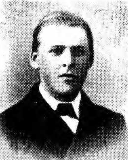
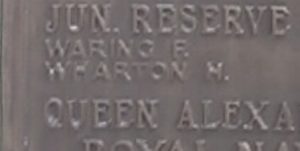
George Wilkins, Corporal, 21552, Royal Welsh Fusiliers. George was the son of Frederick Wilkins and Emma Wilkins (nee Thomas), of Narrow Street, Llanfyllin. He worked as a Draper in London prior to the war, and lodged at 10, Warren Street, Fitzroy Square. George enlisted in London into the 15th Battalion, Royal Welsh Fusiliers soon after the outbreak of war. The battalion was raised in London, before moving to Llandudno on 5 December 1914, joining 128 Brigade, 43rd (Welsh) Division and trained in North Wales before moving to Winchester in the summer of 1915, where the formation became renumbered 113 Brigade, 38th (Welsh) Division. The Division moved to France on 2 December 1915 and moved to the Nursery Sector near Fleurbaix for trench initiation alongside the Guards Division. The Division then held a sector of the line near Cuinchy before marching south to the Somme sector in June 1916 to take part in the assault on Mametz Wood. The 15th RWF moved into positions from Mametz village to take over trenches south of Mametz Wood from the 7th Division on 5 July 1916, and came under artillery fire from the Germans. George was killed in action during the relief that day, just two days before the Division assaulted Mametz Wood. The 38-year-old has no known grave and is commemorated on the Thiepval Memorial, France.
Evan Williams, Private, 9820, Cheshire Regiment. Evan was the son of David and Jane Williams, of Pentre Cottages, Llanfyllin. By 1911 he was lodging at 257, Parc Road, Cwmpark, Treorchy, where he worked as a coal hewer. Evan was probably an Army Reservist, and re-enlisted at Chester into the Cheshire Regiment soon after the outbreak of war. On 16 January 1915 he was drafted to France, joining the 1st Battalion, Cheshire Regiment, which was attached to 15 Brigade, 5th Division. Evan joined the battalion at Bailleul on 20 January, where it was in Divisional Reserve. Four days later the battalion marched out of Bailleul, and began a short tour in the front-line trenches at Wulverghem. On 30 January the battalion was relieved and moved into support at Dranoutre, then on 2 February the battalion moved into support at Bailleul again. This routine was by now the usual system of trench rotation for the infantry battalions on the Western Front, and was to continue throughout the war, with the routine often broken up by supplying working parties or carrying out raids. By 4 March 1915 the Division had moved slightly north, taking over trenches between Ypres and St. Eloi. On 22 April the 1st Cheshire’s were holding the front line at Zillebeke, when fighting broke out to their north, following the launching of a German gas-attack in the Ypres Salient, against a section of line held by French Colonial troops. The Frenchmen fled as the gas rolled onto their positions, and a gap opened in the line, which was only closed after a stubborn resistance was put up by the Canadians, who were ordered to plug the gap. This fighting heralded the opening of the Second Battle of Ypres, and was to rage for weeks. On 29 April the 1st Cheshire’s moved into casements in the Ypres Ramparts, in Brigade Reserve. At dawn on 5 May 1915 the battalion was ordered forward to support the stretched line at Hill 60, and arrived at Larch Wood, before assaulting the new German front line. Evan was killed in action during the assault that day. The 26-year-old has no known grave and is commemorated on the Ypres (Menin Gate) Memorial, Belgium.
Thomas Williams, Private, 41708, Yorkshire Regiment. Thomas was the son of Edward and Jane Williams, of Glanrhyd, Llanwddyn. He married Elizabeth Ellen Edwards of Llanfyllin on 26 February 1913. Thomas enlisted into the Royal Field Artillery, but after being drafted to France in the winter of 1916-17, was transferred to the 6th Battalion, Yorkshire Regiment (Green Howards), which was attached to 32 Brigade, 11th (Northern) Division. The Division had fought at Gallipoli, before being evacuated to Egypt, and had moved to France in the summer of 1916, taking part in the Somme offensive, at the Battle of Flers-Courcelette soon after. The Division wintered on the Somme, enduring one of the coldest winters in years, in terrible conditions, and as the New Year dawned, the 6th Yorkshire’s were in billets at Forceville. Thomas took ill at sometime in January 1917, and was evacuated to hospital at Étaples, where he died of lobar pneumonia on 25 January 1917. The 32-year-old is buried in Étaples Military Cemetery, France.
World War Two, 1939-1945
Robert Francis Beasty, Flight Sergeant, 1109201, Royal Air Force Volunteer Reserve. Robert, known as Bobbie, was born in Shrewsbury on 24 February 1914, the son of Henry Beasty and Sarah Beasty (nee Pugh). His father was killed in France whilst serving with the KSLI in 1918. Bobbie lived with his widowed mother at 8, Maes-y-Dre, Llanfyllin, and worked as a Clerk prior to the war. He enlisted into the Royal Air Force Volunteer Reserve, and was posted to 21 (P)FU, based at RAF Wheaton Aston. On 28 September 1944, Robert was flying aboard an Airspeed Oxford I, Serial HN592, on a training flight, when it crashed near Cannock, killing Robert and his two fellow crewmen. The remains of the 30-year-old Robert were recovered from the crash and brought home for burial in Llanfyllin Cemetery.
William Henry Boote, Private, Royal Welch Fusiliers. William was born in Llanfyllin in 1906, and was raised by his grandparents, William and Elizabeth Boote, at Garth Gell, Llanfyllin. He married Annie Rebecca Thomas at Llanfyllin in 1937, and the couple lived at Rhiwlas Terrace. William was a member of the 7th Battalion, Royal Welch Fusiliers. Very little else is known of him, but he died at Llanfyllin in August 1941, aged 35, and was buried in Llanfyllin Cemetery on 19 August. His widow, Annie, married Hugh Myatt in 1944, and died in 2002.
John Frederick Ellis, Flying Officer, 136727, Royal Air Force Volunteer Reserve. John was born in Hull, the son of Harry Ellis and Emily Ellis (nee Allvin). His parents came to run the Wynnstay Hotel in Llanfyllin just before the outbreak of war. John enlisted into the Royal Air Force Volunteer Reserve, and trained as a Wireless Operator. John was posted to 84 Squadron, RAF at some time in 1942. The squadron had operated in Greece, Iraq, and the Western Desert before moving to the Far East, and flew the Vultee Vengeance dive bomber from Assam in North-East India. On 26 June 1944, John was flying as Wireless Operator aboard Vengeance III, Serial FD105, piloted by Pilot Officer Finnie on an operation flight over enemy occupied territory. According to reports, the cockpit of the aircraft started filling with smoke, and the pilot ordered John to bale out, suspecting that the aircraft was on fire, however, the smoke soon cleared, and the pilot turned around to stop John baling out, only to see him jump, with his parachute unfurling. Finnie flew over the area where John had landed, and could see his parachute draped in some trees, but no trace of John was ever seen again. John was originally presumed to be in Japanese hands, but nothing was heard of him and later his death was officially presumed as being on that date, 26 June 1944. The 29-year-old has no known grave and is commemorated on the Singapore Memorial, Kranji.
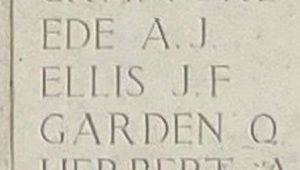
Charles Jones, Sergeant, Royal Air Force. Charles cannot presently be identified, but the memorial states that he lived at Derlwyn, Llanfyllin.
David Ivor Jones, Craftsman, 4201665, Royal Electrical and Mechanical Engineers. David was born at 4, Pendre, Llanfyllin on 16 January 1918, the son of Mary Olwen Jones. He married Alice Mary Humphreys in 1938, and the couple lived at 6, Rhiwlas Terrace, where David worked as a carpenter. He enlisted into the Royal Electrical and Mechanical Engineers, where his trade earned him the rank of Craftsman. David was posted out to Singapore in 1941 with the 18th Division, which then formed part of the massive garrison of the vitally important harbour island. The Japanese launched their invasion of Malaya on 8 December 1941, and on 8 February 1942, began landing on Singapore. On 15 February 1942 the British commander of the Singapore garrison, Lieutenant-General Arthur Percival, infamously surrendered on 15 February 1942, and over 80,000 troops were put into captivity by the brutal Japanese. David was among a large number of men sent to Thailand to work on the Thai-Burma Railway, where his carpentry skills would have been put to use by his captors. He died in captivity on 17 December 1943. The 32-year-old was originally buried along the site of the railway, but in 1946 his grave was exhumed and his remains re-buried in Kanchanaburi War Cemetery, Thailand.
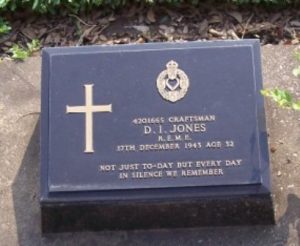
James Evan Jones, Leading Aircraftman, 541047, Royal Air Force. James was the son of John Jones and Margaret Rodgie Jones (nee Morton), of 14, Brook Street, Llanfyllin. He enlisted into the Royal Air Force, and was posted to RAF Stormy Down, an RAF Armament Training School, near Pyle. On 20 November 1940, James was walking along the main road outside the base, when he was knocked down by a motor car and killed. The remains of the 23-year-old were brought home for burial in Llanfyllin Cemetery.
Thomas Ralph Lloyd, Private, 4032194, King’s Shropshire Light Infantry. Thomas was the son of William Ralph Lloyd and Jane Ellen Lloyd (nee Jones), of Red House, Llanfyllin. He was serving with the 1st Battalion, King’s Shropshire Light Infantry when war was imminent, and embarked for France with the battalion, which was attached to the 1st Infantry Division, in 1939. The battalion moved to the German frontier, and was on the Maginot Line when the Germans launched their Blitzkrieg. The Division was then forced to withdraw, together with the remainder of the BEF, towards the safety of the Channel coast. Thomas was killed near Lille, in northern France, on 23 May 1940. The 20-year-old is buried in Lille Southern Cemetery, France. The survivors of the 1st KSLI were later evacuated from Dunkirk some weeks later.
Norman Clifford Mills Lloyd, Fourth Engineer Officer, Merchant Navy. Norman was born at The Hall, Llanfyllin on 3 November 1915. He served with the Merchant Navy aboard the steamer SS Firby, as a Fourth Engineer Officer. At 13.35 on 11 September 1939, Firby, under the command of Thomas Prince, was attacked by the German submarine U-48, which surfaced and used her deck-gun on the defenceless ship, some 270 miles west of the Hebrides. After five hits the crew abandoned ship and the ship was sunk at 15.40 by one torpedo from the submarine. The master and all 33 crew members had safely escaped in the ship’s lifeboats. The Commander of the U-Boat sent a radio transmission to the Admiralty, stating: ‘Transmit to Mr. Churchill. I have sunk British steamer Firby position 59°40N/13°50W. Save the crew if you will please. German submarine.’ The message was received by a US Merchant Ship which relayed it to the British, and the destroyer HMS Fearless was despatched to rescue the sailors. Norman must have been wounded during the sinking, and never fully recovered, as he died at the Memorial Hospital, Machynlleth on 8 December 1941, aged 26. He is buried in Llanfyllin Cemetery. Norman is not commemorated as a casualty of war by the CWGC.
Ian Charles Gordon Moffat, Private, 14434637, Dorsetshire Regiment. Ian was born at Chertsey, Surrey on 15 December 1925, the son of Charles Reginald Moffat, and Dorothy Mabel Moffat (nee Dearing). He worked as the Wynnstay Hotel, Llanfyllin during the early years of the war. Ian enlisted into the army, and was posted to the 1st Battalion, Dorsetshire Regiment. The battalion had seen service in Malta, Egypt, Libya, Tunisia and Italy, attached to the 50th (Northumbrian) Division, before being recalled to Britain at the end of 1943, and landed on Gold Beach on D-Day on 6 June 1944. The battalion saw heavy casualties over the coming weeks, as the Allies pushed to break-out of the Normandy Beach-head. Ian was killed in near Condé-sur-Noireau during an assault on 12 August 1944. The 18-year-old has no known grave and is commemorated on the Bayeux Memorial, France.
David Geraint Owen Richards, Apprentice, Merchant Navy. David was the son of the Reverend John Harris Richards and Mary Jane Richards (nee Owen), of Eirianfa, Llanfyllin. He enlisted into the Merchant Navy as an Apprentice at the outbreak of war, and was posted aboard the London registered steamship, SS Tregarthen. In May 1941, the ship sailed from Cardiff for Kingston, Jamaica, with a cargo of coal, joining Convoy OB-329, which had left Liverpool on 31 May 1941. Halfway across the Atlantic, on 6 June 1941, Tregarthen was torpedoed and sunk by the German Submarine U-48. David was 28-years-old when he drowned in the sinking that day, and is commemorated on the Tower Hill Memorial, London.
Leonard Roberts, Private, 13030212, Hampshire Regiment. Leonard was born on 27 December 1914, the son of William R Roberts and Emma Roberts (nee Oakes), of Bucklow, Chester. He married Ethel Davies, of Llangedwyn, in 1940. Leonard enlisted into the army and was posted to the 1st Battalion, Hampshire Regiment, which by April 1943 had moved to North Africa. In July 1943, the Battalion took part in Operation Husky, the invasion of Sicily, and saw heavy fighting against the Herman Goring Parachute Panzer Division. The battalion saw further heavy fighting on Sicily over the coming weeks, before landing in Sicily on 8 September 1943. The battalion took part in the slow advance north, before returning to England by November 1943, to prepare for the D-Day Landings. The battalion joined the 50th (Northumbrian) Infantry Division, and on 6 June 1944 landed on Normandy, capturing Le Hamel and Arromanches. At the end of June, the battalion began to attack the village of Hottot, against the German Panzer-Lehr-Division, and on 11 July 1944 the battalion saw severe fighting against this elite German unit. Leonard was killed in action during the fighting that day. The 29-year-old was originally buried near Hottot, with several other men, but in September 1945 their graves were relocated into Bayeux War Cemetery, France.
Hugh Edward Wharton, Company Quarter Master Serjeant, 1851184, Royal Engineers. Hugh was born at Llanfyllin in 1887, the son of Ernest Wharton and Susannah Wharton (nee Pughe), of Green Square. The family had moved to Cork, Ireland, by 1901, then prior to the war had moved to 4, Springfield Terrace, Crumlin, Dublin. Hugh was a regular soldier, and had served with the Royal Engineers for several years prior to the war. He married Florence Marjorie Shaw, of Scarborough, at Liverpool in 1940, prior to being posted to Greece with 580 Army Troops Company, Royal Engineers. Hugh had been posted at Fort Crosby, Hightown, where his unit was part of the Mersey Defences, where detachments of the unit operated generators and searchlights. At the beginning of January 1941, the company embarked at Glasgow, and sailed via Gibraltar, Freetown and Cape Town to Port Tewfik on the Suez Canal, and in March the Company was sent as part of a strong force to Greece, to assist the Greek Army against a probable German invasion. The Germans attacked Greece on 5 April 1941, and the Allies were forced to retreat. On 19 April it was decided to begin evacuation from the port of Piraeus, which was already under air attack. Hugh was killed on 23 April 1941, while his Company was helping stem the German advance. The 54-year-old is buried in Phaleron War Cemetery, Athens. His brother Harold had been killed in the Great War. Harold is commemorated on the Llanfyllin war memorial, whilst Hugh is not.
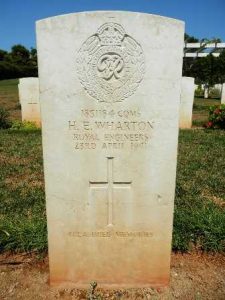
John Clifford Worthington, Fusilier, 14504998, Royal Welch Fusiliers. John was the son of John Worthington and Catherine Jane Worthington (nee Goodwin), of Tan-y-Dorlan, Llanfyllin. He enlisted into the 1st Battalion, Royal Welch Fusiliers. The battalion had been in France with the BEF at the start of the war and saw heavy fighting as it withdrew across Norther France, with very few men reaching Dunkirk for evacuation. After two years spent in the United Kingdom, the 1st RWF was sent to India with the 2nd Division, to take part in the fight against the Japanese. The most notable action the battalion took part in was the infamous Battle of Kohima, or the ‘Stalingrad of the East’, a terrible, prolonged battle, that raged between April and May 1944. John survived Kohima, but died at Mandalay, Burma on 9 March 1945. The 25-year-old was originally buried in Mandalay War Cemetery, but after the war, all of the graves within the cemetery were exhumed and re-buried in Taukkyan War Cemetery, Myanmar.